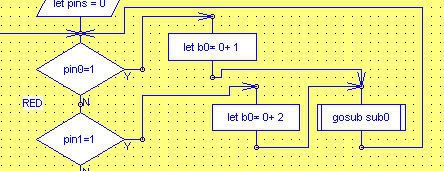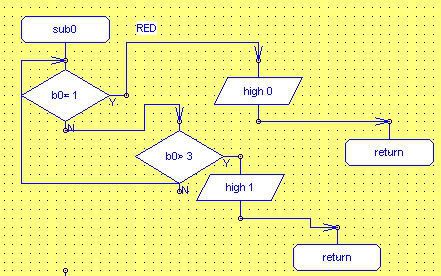Cdawilliams
New Member
Not sure if anyone can help me but you never know unless you ask so here goes. I'm designing a game for a mini project of mine but have never been very good with the Picaxe software, mainly working in Flowchart mode but still I hit certain snags so was wondering if anyone could help.
Basically this is what I currently have:
http://www.rapidonline.com/Electronic-Components/Integrated-Circuits/PICAXE/28-pin-Project-board/61482/kw/28-Pin
This is the general idea:
A player throws a ball at switches mounted on a case, different switches depend on different scores (similar to the Inner and Outter rings on a Dart Board), the first player to Light up their 4 Outputs (LED's) Wins. HOWEVER - different players can accidentally hit the other players switch making the game in itself a little tricker.
So here's the slightly more technical side, there are 16 switches, 8 of one colour, 8 of another (The two colours represent a different team) - Not sure if its relevant but they are Push-to-Make siwtches.
I also have 8 LED's, again 4 of one colour, 4 of another. Representive of the two different teams.
Below are two images of what it roughly will look like to give a better idea of what I mean:
Top View:

ISO View:

Now the idea is "if" the Outter Switches get hit it lights up 2 LED's of that colour, E.g. If 'green' outter switch is hit then 2 'green' LED's light up and same for red. *Colours may vary but you get the idea*
However "if" the Inner Switches get hit it lights up 1 LED of that colour.
Now so far I've got the basic program, I can make the LED light up if the Input (Switch) is hit and I have programmed a Delay on all as the intention is to hit the switch with a ball that may bounce so I don't wish it active two LED's by hitting the same Switch twice for example.
The start of the program turns all outputs to off which is fine.
The Problem (Sorry if I've bored you):
I think I need some sort of memory log but I'm having an issue with this scenario:
If an Outter Input is Hit, a Single Input lights, however I'm having trouble stacking it.
E.g. Outter Hit + Inner Hit = 3 Outputs Light Up
Outter Hit + Outter Hit = 2 Outputs Light Up
Inner Hit + Inner Hit = 4 Outputs Light Up (Technically a Win)
Now this is where I have been getting stuck, I don't know how to make it so that once an output is hit then another is hit, to make them stack so that 2, 3 or 4 or Active all at once instead of simply replacing the last.
What I have so far: (May be difficult to read)

As I said, as an amateur with Picaxe its been a real road block so any help at all would be greatly appreciated. Also I know its a lot to digest and I have tried to make it as easy as possible in terms of understand to read but if you are finding trouble understand certain aspects just ask and i'll try clarify in hope that someone out there with a much bigger knowledge than myself can help.
Thank you taking the time to listen and even more so if you can help.
Sincerely,
Chris
Basically this is what I currently have:
http://www.rapidonline.com/Electronic-Components/Integrated-Circuits/PICAXE/28-pin-Project-board/61482/kw/28-Pin
This is the general idea:
A player throws a ball at switches mounted on a case, different switches depend on different scores (similar to the Inner and Outter rings on a Dart Board), the first player to Light up their 4 Outputs (LED's) Wins. HOWEVER - different players can accidentally hit the other players switch making the game in itself a little tricker.
So here's the slightly more technical side, there are 16 switches, 8 of one colour, 8 of another (The two colours represent a different team) - Not sure if its relevant but they are Push-to-Make siwtches.
I also have 8 LED's, again 4 of one colour, 4 of another. Representive of the two different teams.
Below are two images of what it roughly will look like to give a better idea of what I mean:
Top View:

ISO View:

Now the idea is "if" the Outter Switches get hit it lights up 2 LED's of that colour, E.g. If 'green' outter switch is hit then 2 'green' LED's light up and same for red. *Colours may vary but you get the idea*
However "if" the Inner Switches get hit it lights up 1 LED of that colour.
Now so far I've got the basic program, I can make the LED light up if the Input (Switch) is hit and I have programmed a Delay on all as the intention is to hit the switch with a ball that may bounce so I don't wish it active two LED's by hitting the same Switch twice for example.
The start of the program turns all outputs to off which is fine.
The Problem (Sorry if I've bored you):
I think I need some sort of memory log but I'm having an issue with this scenario:
If an Outter Input is Hit, a Single Input lights, however I'm having trouble stacking it.
E.g. Outter Hit + Inner Hit = 3 Outputs Light Up
Outter Hit + Outter Hit = 2 Outputs Light Up
Inner Hit + Inner Hit = 4 Outputs Light Up (Technically a Win)
Now this is where I have been getting stuck, I don't know how to make it so that once an output is hit then another is hit, to make them stack so that 2, 3 or 4 or Active all at once instead of simply replacing the last.
What I have so far: (May be difficult to read)

As I said, as an amateur with Picaxe its been a real road block so any help at all would be greatly appreciated. Also I know its a lot to digest and I have tried to make it as easy as possible in terms of understand to read but if you are finding trouble understand certain aspects just ask and i'll try clarify in hope that someone out there with a much bigger knowledge than myself can help.
Thank you taking the time to listen and even more so if you can help.
Sincerely,
Chris


